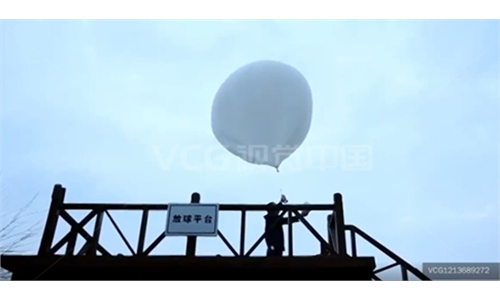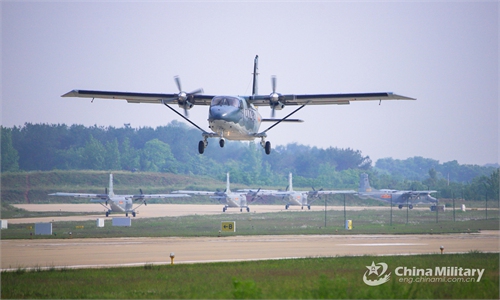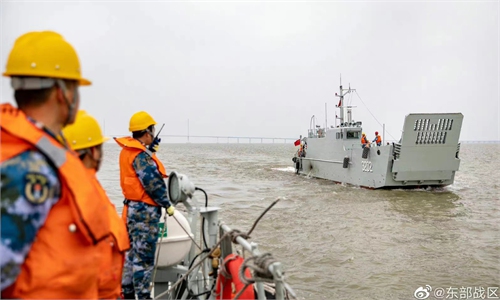China's defense budget expected to grow at around 7% in 2022 amid security threats: experts
Analysts cite economy, geopolitical uncertainties, devt needs as factors
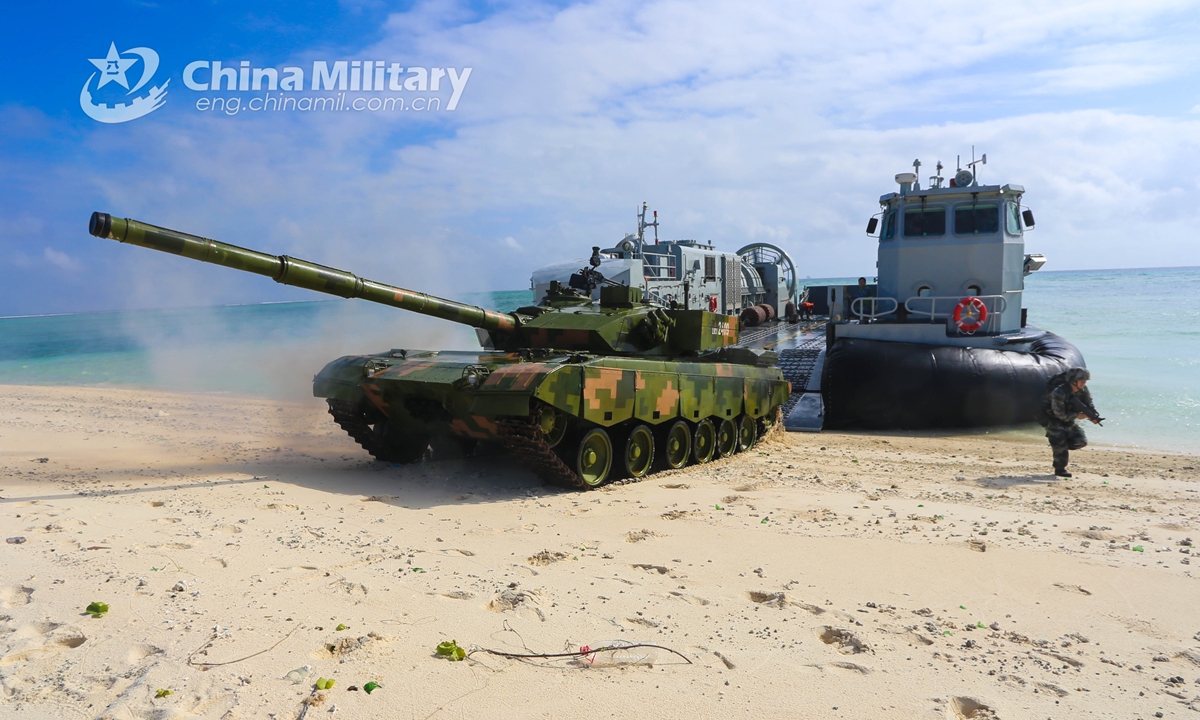
An army main battle tank rolls out of a naval air cushioned landing craft during a joint combat training exercise conducted by an army brigade and a naval landing ship group under the PLA Southern Theater Command on Feb 8. Photo:China Military
Ahead of China's announcement of its defense budget for 2022, analysts and observers predict that the country will likely continue to steadily increase its military expenditure, at a rate possibly slightly faster than last year, as China enjoys a positive economic development but faces security threats. The two factors provide a foundation and need for China to further develop its national defense capabilities to safeguard national sovereignty, territorial integrity and rightful interests.
The amount is expected to be released in a draft budget report at the opening of the annual session of the National People's Congress, the country's top legislature, on Saturday.
Multiple military experts reached by the Global Times believe that the budget could grow by about 7 percent.
In March 2021, China announced a defense budget of 1.35 trillion yuan ($209 billion), a 6.8 percent increase, faster than the 6.6 percent increase in 2020, despite COVID-19, which had an impact on China's economic growth in both years.
China has maintained a single-digit growth in its annual defense budget since 2016.
China will likely continue to expand its military expenditure this year, as the defense spending should be closely related to the development of the national economy, Fu Qianshao, a Chinese military expert, told the Global Times.
While the economy has been affected by COVID-19, China did well with epidemic prevention and control, and is enjoying a relative healthy economy development. So it is likely that China will spend more on national defense, Fu said.
China's GDP expanded at 8.1 percent in 2021, growing the fastest in nearly a decade and landing well above the government's annual target of achieving a growth rate above 6 percent for that year.
Despite the 8.1 percent GDP growth last year, China could still face pressure in its economic development this year under the uncertainties of the coronavirus, so a 7 percent growth in the defense budget should make sense, as this is also a rough average of the past six years, Shi Hong, executive chief editor of the Chinese magazine Shipborne Weapons, told the Global Times.
Song Zhongping, a Chinese military expert and TV commentator, also predicted a 7 percent hike.
"I estimate this year's GDP growth not to be as high as last year's 8.1 percent, and the target will likely be put at 5 to 6 percent. But there is no way China will cut its military budget growth because of this. On the contrary, I think it should be higher than last year's," Song said.
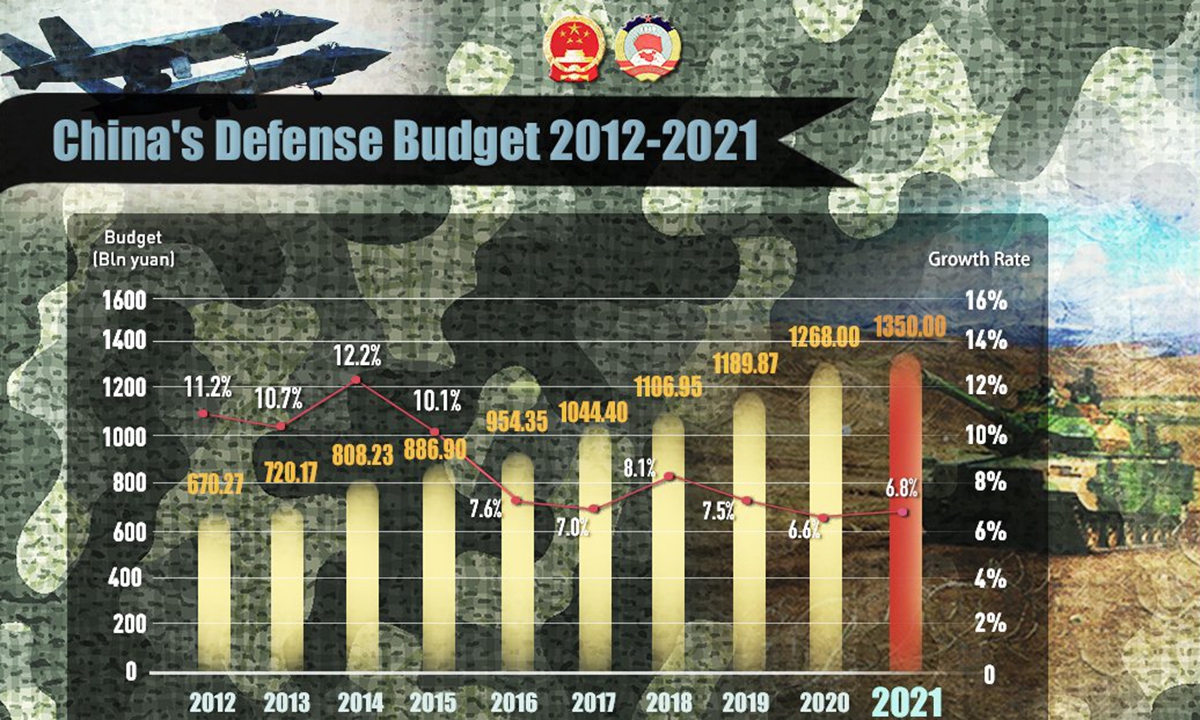
China increased its 2021 defense budget by 6.8 % to 1.35 trillion yuan ($209 billion) in a quicker pace than last year's 6.6% growth, which analysts believe is normal, steady and restrained as China resiliently emerges from COVID-19 pandemic.
Spending needed
While economic development provides a foundation for a possible defense budget increase, the security threats China is facing and the demands for national defense capability enhancement caused by those threats are the driving factors, analysts pointed out.
The US has been applying military pressure on China over the past few years, stirring up trouble on the doorsteps of China through operations like provocative, monthly warship transits in the Taiwan Straits, close-in reconnaissance missions with spy planes in the East China Sea and the South China Sea of more than 1,200 times in 2021, and a number of warship intrusions in Chinese territorial waters in the South China Sea in the name of "freedom of navigation."
Over the past year, the US also rallied its allies and partners around the world to provoke and confront China militarily. Under the US' bullying banner, countries far away from the region like France, Germany and the UK sent warships to the South China Sea. The US also organized the security dialogue Quad with Japan, India and Australia, and formed the new security pact AUKUS with Australia and the UK, both designed to surround China militarily.
The US conducted intensive military exercises near China in 2021, as its aircraft carrier strike groups and amphibious ready groups entered the South China Sea 13 times, more than double the activities of 2020, and at least 11 US nuclear-powered attack submarines were spotted in or near the South China Sea, according to monitoring from the South China Sea Strategic Situation Probing Initiative, a Beijing-based think tank.
The US' new weapons and equipment, like the next-generation attack nuclear submarine, destroyer, fighter jet, and B-21 bomber and hypersonic missiles, are also being developed with China in mind, another Chinese military expert told the Global Times, requesting anonymity.
US President Joe Biden is expected to ask US Congress for a defense budget exceeding $770 billion for the next fiscal year, eclipsing the record budget requests by former president Donald Trump, Reuters reported on February 17. This means the US' defense budget will remain about four times China's.
China remains the only permanent member of the UN Security Council that has yet to realize complete national reunification. The secessionist Democratic Progressive Party authority on the island of Taiwan repeatedly made provocations over the past years, attempting to resist reunification by developing new weapons and purchasing them from foreign countries, including recent plans to buy US-made howitzers and Patriot missile upgrades.
While the situation along the China-India border has been kept stable and manageable, the standoffs remain to be completely solved after rounds of talks.
These circumstances also mean that China needs to continue to increase its national defense capabilities with steadily growing budgets, Fu said, noting that China will also not be involved in an arms race, as it has kept its defense spending at only 1.3 percent of its GDP in recent years, far lower than the US.
The money will be used to boost the modernization of the Chinese military, including procuring and commissioning more advanced weapons and equipment in terms of both quality and quantity, strengthening the realistic combat-oriented training, and the welfare of military personnel, experts said.
In 2022, China will likely launch its third aircraft carrier, expand production of the J-20 stealth fighter jet, and modernize its nuclear arsenal, which all needs the support of a sufficient budget, observers said.
The communiqué of the fifth plenary session of the 19th Central Committee of the Communist Party of China, held in Beijing in October 2020, made "making significant strides in the modernization of national defense and armed forces in the next five years" one of the main goals for the development of the economy and society in the 14th Five-Year Plan, and stressed that the development of the economy should go side-by-side with the strengthening of the military.
By the 100th anniversary of the founding of the PLA in 2027, the centennial goal of military development should be achieved; by 2035, the country should achieve modernization of the national defense and armed forces, it was announced at the plenary session.
To meet this roadmap, increasing defense budgets over consecutive years is needed, analysts said.

